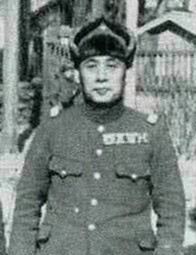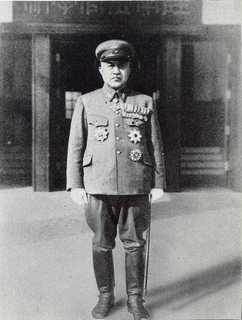Japan
North China Area Army – Juichi Terauchi [2]
- 1st Army – Kiyoshi Katsuki
- 14th Division – Kenji Doihara
- 27th Infantry Brigade
- 2nd Infantry Regiment
- 59th Infantry Regiment
- 28th Infantry Brigade
- 15th Infantry Regiment
- 50th Infantry Regiment
- 20th Field Artillery Regiment
- 18th Cavalry Regiment
- 14th Engineer Regiment
- 14th Transport Regiment
- 27th Infantry Brigade
- 108th Division – Kumaya Shimomoto
- 25th Infantry Brigade
- 117th Infantry Regiment
- 132nd Infantry Regiment
- 104th Infantry Brigade
- 52nd Infantry Regiment
- 105th Infantry Regiment
- 108th Field Artillery Regiment
- 108th Cavalry Regiment
- 108th Engineer Regiment
- 108th Transport Regiment
- 25th Infantry Brigade
- 20th Division – ?
- 39th Infantry Brigade
- 77th Infantry Regiment
- 78th Infantry Regiment
- 40th Infantry Brigade
- 79th Infantry Regiment
- 80th Infantry Regiment
- 26th Field Artillery Regiment
- 28th Cavalry Regiment
- 20th Engineer Regiment
- 20th Transport Regiment
- 39th Infantry Brigade
- 109th Division – ?
- 31st Infantry Brigade
- 69th Infantry Regiment
- 107th Infantry Regiment
- 118th Infantry Brigade
- 119th Infantry Regiment
- 136th Infantry Regiment
- 109th Mountain Artillery Regt
- 109th Cavalry Regiment
- 109th Engineer Regiment
- 109th Transport Regiment
- 31st Infantry Brigade
- Forces directly under 1st Army: **
- 4th Independent Machinegun Battalion
- 5th Independent Machinegun Battalion
- 9th Independent Machinegun Battalion
- 1st Independent Light Armored Car Squadron
- 5th Independent Light Armored Car Squadron
- 2nd Tank Battalion
- 1st Independent Mountain Artillery Regiment
- 3rd Independent Mountain Artillery Regiment
- 2nd Field operation Heavy Artillery Regiment
- 5th Field operation Heavy Artillery Regiment
- 6th Field operation Heavy Artillery Regiment
- 8th Independent Field Heavy Artillery Regiment
- 3rd Artillery Battalion
- 5th Artillery Battalion

The 20th Division was an infantry division in the Imperial Japanese Army. Its tsūshōgō code name was the Morning Division. The 20th Division and the 19th Division were both raised as a garrison force for Korea. After Japan's victory in the Russo-Japanese War of 1904-1905, and subsequent occupation, and then annexation of Korea in 1910, the need was felt for a dedicated garrison force, raised from people with local knowledge. The 20th Division was stationed in central Korea, in what is now Yongsan District, Seoul. The division received its colors on 24 December 1915; however, the division was not considered combat-ready until 1918, and divisional headquarters were co-located with the division only from the 1 April 1919. The delay was due to limited funding available for the division to build its facilities in Korea and the need to recruit and train personnel from mainland Japan. The first commander of the 19th Division was Lieutenant General Tachibana Koichirō.
- 14th Division – Kenji Doihara
- 2nd Army – Toshizō Nishio, Field Marshal Prince Naruhiko Higashikuni (from 30 Apr 1938)
- 16th Division – Kesou Nakashima
- 9th Infantry Brigade
- 9th Infantry Regiment
- 20th Infantry Regiment
- 30th Infantry Brigade
- 33rd Infantry Regiment
- 38th Infantry Regiment
- 22nd Field Artillery Regiment
- 16th Engineer Regiment
- 16th Transport Regiment
- 9th Infantry Brigade
- 5th Division [3]
- 10th Division [4]

The 16th Division was an infantry division in the Imperial Japanese Army. Its tsūshōgō code name was the Wall Division, and its military symbol was 16D. The 16th Division was one of four new infantry divisions raised by the Imperial Japanese Army in the closing stages of the Russo-Japanese War (1904–1905). With Japan's limited resources towards the end of that conflict, the entire IJA was committed to combat in Manchuria, leaving not a single division to guard the Japanese home islands from attack. The 16th Division was initially raised from men in the area surrounding Kyoto 18 July 1905 under the command of Lieutenant General Yamanaka Nobuyoshi.
The 5th Division was an infantry division of the Imperial Japanese Army. Its call-sign was the Carp Division. The 5th Division was formed in Hiroshima in January 1871 as the Hiroshima Garrison, one of six regional commands created in the fledgling Imperial Japanese Army, and was destroyed in the battle of Okinawa in June 1945. Its personnel were drafted from Hiroshima, Yamaguchi and Shimane.

The 10th Division was an infantry division in the Imperial Japanese Army. Its tsūshōgō code name was the Iron Division. The 10th Division was one of six new infantry divisions raised by the Imperial Japanese Army in the aftermath of the First Sino-Japanese War, 1 October 1898. Its troops were recruited primarily from communities in the three prefectures of Hyōgo, Okayama and Tottori, plus a portion of Shimane. It was originally headquartered in the city of Himeji, and its first commander was Lieutenant General Prince Fushimi Sadanaru.
- 16th Division – Kesou Nakashima
- Directly under North China Front Army:
- 114th Division – ? (from Central China Front Army) [5]
- 127th Infantry Brigade
- 66th Infantry Regiment
- 115th Infantry Regiment
- 128th Infantry Brigade
- 102nd Infantry Regiment
- 150th Infantry Regiment
- 120th Field Artillery Regt
- 118th Cavalry Regiment
- 114th Engineer Regiment
- 114th Transport Regiment
- 127th Infantry Brigade
- China Mixed Brigade – ? [6]
- 1st China Stationed Infantry Regiment – Colonel Hasegawa
- 2nd China Stationed Infantry Regiment – Colonel ?
- China Garrison Cavalry Unit
- China Garrison Artillery Regiment – Colonel ?
- China Stationed Engineer Unit
- China Stationed Signal Unit – ?
- 3rd Independent Mixed Brigade – ? [7]
- 6th Independent Infantry Battalion
- 7th Independent Infantry Battalion
- 8th Independent Infantry Battalion
- 9th Independent Infantry Battalion
- 10th Independent Infantry Battalion
- Independent Artillery Troops
- Independent labor troops
- Signal Communication unit.
- 4th Independent Mixed Brigade – ? [8]
- 11th Independent infantry Battalion
- 12th Independent infantry Battalion
- 13th Independent infantry Battalion
- 14th Independent infantry Battalion
- 15th Independent infantry Battalion
- Independent Artillery Troops
- Independent labor troops
- 5th Independent Mixed Brigade – ? [9]
- 16th Independent Infantry Battalion
- 17th Independent Infantry Battalion
- 18th Independent Infantry Battalion
- 19th Independent Infantry Battalion
- 20th Independent Infantry Battalion
- Independent artillery troops
- Independent labor troops
The 114th Division was an infantry division of the Imperial Japanese Army. Its call sign was Commander Division. It was formed on 12 October 1937 in Utsunomiya, Tochigi as a B-class square division. The nucleus for the formation was the 14th Division headquarters. It was originally subordinated to the Central China Area Army.
- 114th Division – ? (from Central China Front Army) [5]

Kiyoshi Katsuki was a general in the Imperial Japanese Army in the Second Sino-Japanese War.

The 14th Division was an infantry division in the Imperial Japanese Army. Its tsūshōgō code name was the Shining Division, and its military symbol was 14D. The 14th Division was one of four new infantry divisions raised by the Imperial Japanese Army (IJA) in the closing stages of the Russo-Japanese War, after it turned out that the entire IJA was committed to combat in Manchuria, leaving not a single division to guard the Japanese home islands from attack.

Kenji Doihara was a general in the Imperial Japanese Army in World War II. He was instrumental in the Japanese invasion of Manchuria for which he earned fame taking the nickname "Lawrence of Manchuria," a reference to Lawrence of Arabia. However, according to Jamie Bisher, the flattering sobriquet was rather misapplied, as that Colonel T.E. Lawrence had fought to liberate, not to oppress people. In a war fiction by Roger J. Spiller, Lieutenant-General Ishiwara Kanji, his military chief in Manchuria, said that his heavy addiction to opium contributed to his unreliability as an army officer.

